Izabelin
Borough of Nieporęt , Legionowski District, Mazowieckie VoivodshipType of place
Forest and meadowInformation about the crime
We went to Izabelin for the first time in the summer of 2022. We were invited by the “Nieporęt Genealogies” Association (Stowarzyszenie “Genealogie Nieporęckie”). Members of the Association told us about the forgotten Jewish labor camps that functioned in the commune from spring to October 1942. Jewish women and men were extracting peat. Women stayed in the camp called “Żandary” (probably together with a small number of children), whereas men stayed in the so-called “magistracki” camp.
According to the Association’s research, the following people worked in the camp:
– 50 Jews from Jadów,
– 100 Jews from Radzymin,
– 80 Jews from Wołomin.
In total, there were approximately 230 people in the camp.
The following description of working conditions in the camp was provided to us by the Association’s researchers based on the Book of Remembrance of the Jews of Radzymin:
“People worked in the camp from dawn to dusk. They loaded the peat onto the cars and pushed them to the grinder. Every day, each prisoner made about 25 trips on a route of about half a kilometer. Due to the poor condition of the tracks, the cars often fell off the rails and had to be placed on the tracks manually. Jewish prisoners received half a loaf of bread a day: a quarter in the morning and a quarter in the evening, ersatz coffee and a small bowl of watery soup. Some of the prisoners received food from their homes (especially bread). Those who were not so lucky grew weaker day by day. Poles were employed in digging peat. They were doing piecework – the more they did, the more they were paid. All dug up peat had to be processed on the same day, so the Jewish prisoners worked until all the peat was processed. They did not stop working even in the rain. Work was interrupted only in the event of heavy and prolonged storms. Prisoners were housed in simple barracks (huts) with lousy straw for bedding and no sanitary equipment. Sometimes prisoners were allowed to visit the ghetto in Radzymin. The inhabitants of the ghetto could also visit the prisoners. Workers were provided with food and other services (e.g. hairdressing). This was done not only by the residents of the Radzymin ghetto, but also by the local residents.”
The Yad Vashem archive contains an account of Abraham Chonowicz, born in 1924 (Yad Vashem Item ID 3556906, 3562740), a prisoner from the peat mine in Izabelin. “Abraham was sent to the Izabelin camp in May 1942, instead of his older brother. The wake-up call was at five in the morning and after a short time for eating and washing, the prisoners started working. Work lasted until nine in the evening, with a half-hour break. The prisoners dug up the peat, loaded it into cars, unloaded it and laid it out for drying, and then loaded the dried peat back into the cars. The peat-digging workers stood waist-deep in water. Prisoners slept in barracks on straw. The barracks were closed and the prisoners were counted in the morning. Jews who didn’t work efficiently enough were beaten with metal clubs – often to death. Polish people were the cooks. Abraham ate pork fat for the first time, which gave him food poisoning. In the camp there was barely any food. Abraham’s family, who remained in the Wołomin Sosnówka ghetto, provided him with food. According to Abraham, the mine belonged to Count Potocki – this information is different than in other accounts, where it is referred to as the magistrate mine or belonging to the capital city of Warsaw”. (summary of the report by researchers from the “Genealogie Nieporęckie” Association)
Before the final liquidation of the labor camp took place, a large group of prisoners escaped:
“On July 7, 1942, the liquidation of the Warsaw ghetto began, followed by the liquidation of ghettos in all cities in the vicinity. When it was time to liquidate the ghetto in Radzymin, at 1:00 am on October 3, 1942, the prisoners escaped from the camp in Izabelin. About 70 men survived the escape. The refugees hid in the forest. They all sought refuge – some with farmers, others pretending to be Christians with false papers (as long as they didn’t look Jewish). A few tried to the forests in eastern Poland to join the guerrillas. The camp in the forest existed almost three weeks after the liquidation of the ghetto in Radzymin. On October 24 at 4:00 in the morning, while it was still completely dark, a car arrived with 12 military policemen armed with rifles. They proceed to liquidate the camp. About twenty Jews were caught and shot by military policemen. Before being shot, the victims were undressed so that the bullets would not damage their clothes. One boy escaped naked and wounded. Among the murdered were Jews from Radzymin: Mosze Morgenstern, Itza “kulawy” [lame-FZ], Butshe Kochnowitz, Wegman brothers: Mosze and Itza, Friedman (the tailor’s son) and many others.” (based on the Radzymin Yizkor Book).
The final liquidation of the labor camp took place in October (or later) 1942. About 160 prisoners were murdered at that time.
“In the morning, the mine workers and camp prisoners were told not to go anywhere, because there would be a hunt in the forest. Later, the German military police arrived. The prisoners were ordered to dig their own graves, strip naked, and were shot. It took place near the mine where Poles worked”. (Izabelin, September 6, 2022)
Memories of H., a local resident.
“The camp was near Złodziejska Góra. It wasn’t fenced. Next to the sheds where the Jews lived, there was a kitchen where a Polish woman living nearby cooked.
“Poles had to bury Jews – at least 100 of them. Among the murdered were young boys aged 15-16. Some of the Jews were still alive when they were buried. The pits in which the victims were buried were deep – there was water at the bottom.” (from the resources of the “Genealogie Nieporęckie” Association)
“- So about 160 people were killed during execution and they are buried in one place?
– Yes. Now there is a forest in this place. Elderly say that it was near the forest, because there was no forest there at that time.
– Were other people who died buried close to this place or was there a cemetery? The seventy people who got away?
– We don’t know that. We don’t know if they gathered them together and shot them or just shot them one by one”. (Izabelin, September 6, 2022)
Polish witnesses recall the escape of a wounded Jew who managed to escape during the shooting. The wounded man reached the buildings in Izabelin, where he was fed and given clothes. Supposedly, he was a doctor or feldsher.
In the execution card of the Commission for the Prosecution of Crimes against the Polish Nation here is a similar account about the murder of about 80 people: “I don’t remember what season it was, but it was chilly, and the morning was foggy. I heard the shots, as it was only about 3 kilometers away. The shoots came from the forest behind the meadows adjacent to Izabelin, where several dozen Jews were shot. After a few hours I saw a walking man in torn underwear. He had blood all over him. He came all the way to the village and disappeared among the buildings. He was spotted and transported further away, where the Germans searched and executed some wounded Jews who managed to escape”. (IPN Bu 2448/970) However, both this testimony and the 1945 questionnaire mention spring 1944. The second document contains information about several escapes from the execution site. The victims were supposedly buried in a 4×10 meter grave “at the edge of the forest, near the peat bog”. Testimony of Zygmunt R. (IPN Gk 163/45)
“Some of them escaped. They were later caught in forests and executed. Only two people manage to save themselves from this execution. Escapes had happened before. The local population provided us with the information that people prepared dugouts to hide fugitives. Among the bushes, somewhere in the fields, or in an attic or a barn. They were in hiding for a while, got food, got clothes and went on. These accounts show that no one hid until the end of the war. Rather, they got emergency aid and went on due to the safety reasons”. (Izabelin, September 6, 2022)
Tzipora Levita-Grodzitska had good looks and Aryan papers, so she could move freely on the Aryan side. She was involved in smuggling between the ghettos and the surrounding villages. She took goods for sale from the ghettos and returned with food to the ghettos in Warsaw and Wołomin (Sosnówka). The day before the liquidation of the ghetto in Wołomin, she and her sister went to a camp in the peat mine in Izabelin where 80 young Jews from Wołomin worked, according to an agreement between the Germans and the Judenrat. She left the ghetto together with the military policemen, who came twice a week to collect a bribe in gold and silver. They planned to return to Wołomin the same day in the evening, but could not find a transport, so they spent the night in Izabelin.
They heard shots at night, but they didn’t know where they were coming from. Shortly before sunrise, at four o’clock in the morning, the teenage boy Brondshtein (?) came to them and said that the ghetto had been liquidated. He jumped off the transport to Treblinka. The sisters went to Milanówek, found a job in Warsaw and occasionally visited Izabelin.
A few weeks later, Tzipora passed a group of smiling military policemen on horses on her way to Izabelin. When she arrived, the camp was eerily silent. The Polish supervisor, Frank, sat on the threshold of the lodge and played his accordion quietly. Shocked to the core, Tzipora followed Frank to the hill where the murdered were buried. The head of Shabtai Dubner’s young son was sticking out of the ground. (https://www.jewishgen.org/yizkor/wolomin/wol377.html)
Very little is known about the women’s camp.
“We don’t know where the women and children were buried. Here, in Zandary there was no forest and still there is not. I heard very dramatic accounts. They did not waste bullets on children. […]
– They mined the peat, just like the men.
– Is Żandary a local name?
– No, it refers exclusively to the camp. The fact that women worked there is not surprising. This peat mine was already in operation before the war, and a lot of women were employed there then, too.
This we have accounts from friends that my grandmother worked, the photos are of the machine that was the press there. And after the war they also worked here, women also worked here. My friends told me that my grandmother worked there. I saw photos of the machine that was a press. And after the war, women also worked here.
– Were they Jewish women from Radzymin or Wołomin? Were any towns mentioned?
– We think so, and so do men. Because the men came mainly from the ghettos in Radzymin, Jadów and Wołomin. They probably weren’t from the Legionowo area. There were very few Jews in Nieporęt and the surrounding area before the war. No more than a dozen Jewish families lived in Nieporęt.
The liquidation of the women’s and men’s camps took place on the same day. At least that’s what we get from the accounts we had, as no accounts of women have been preserved. Simply because no one survived it.
– How big was the women’s camp?
– We don’t know anything.
– Is there any indication of the burial place? Has anyone ever said anything?
– No”. (Izabelin, September 6, 2022)
IDENTIFICATION OF THE GRAVE BASED ON NON INVASIVE RESEARCH
On September 27, 2023, a site inspection was carried out in the place indicated by witnesses as the area of collective burial sites of Holocaust victims. (approximate GPS coordinates: N 52°23.616’E 021°05.028′).
It is a forested, wetland area, qualifying as a swamp/peat bog.
The LiDAR shows a heavily disturbed, extensive trapezoid-shaped area. Some of the visible soil disturbances occurring in this location are highly likely to be the remains of human activity. In the north-eastern corner of the trapezoid there are clear traces of large excavations (soil disturbances). This area is located close to the road, which is the only communication route leading to the indicated area.
The archival aerial photographs query for this area is ongoing.
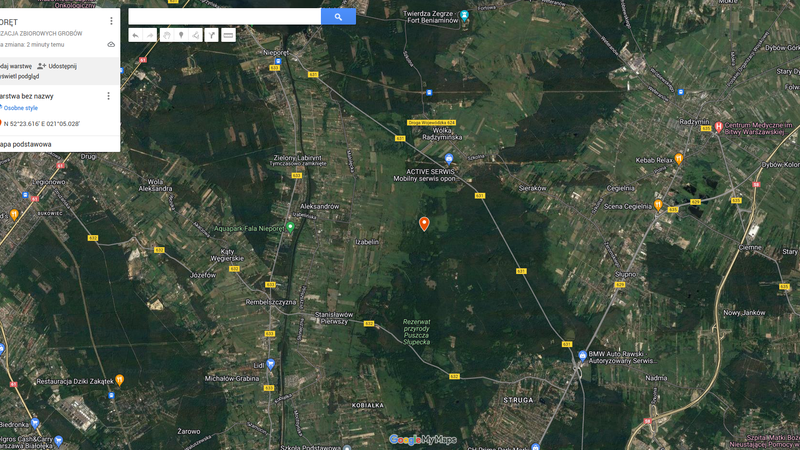 Izabelin fotografia satelitarna 1a
Izabelin fotografia satelitarna 1a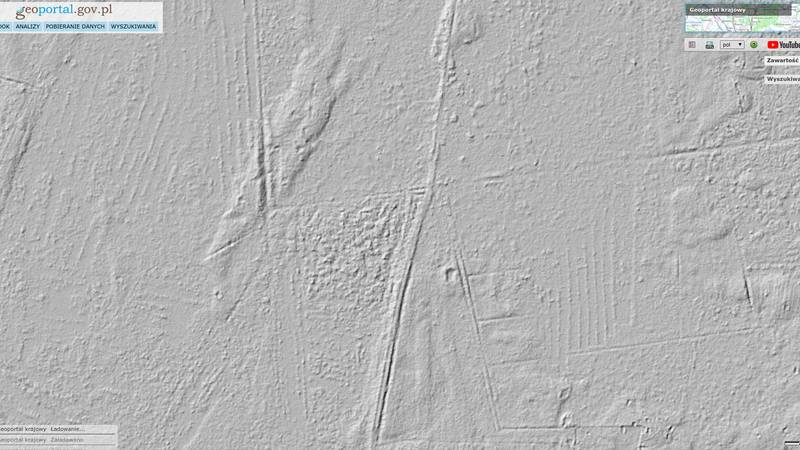 Izabelin LiDAR 1
Izabelin LiDAR 1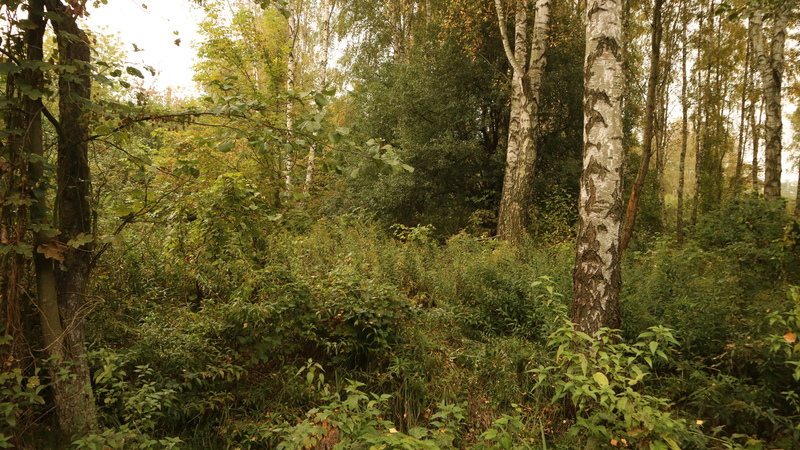 Izabelin fotografia 1 lokalizacji
Izabelin fotografia 1 lokalizacjiTranskrypcje
Contact and cooperation
We are still looking for information on the identity of the victims and the location of Jewish graves in Izabelin. If you know something more, write to us at the following address: fundacjazapomniane@gmail.com.
Bibliography
IPN Bu 2448/970
IPN Gk 163/45 Surveys. Execution. Graves. Warszawskie voivodeship; vol. V; Questionnaires about mass executions and mass graves – warszawskie province.
Recording of the Zapomniane Foundation (audio file), name: members of the “Genealogie Nieporęckie” Association, topic and keywords: Jewish labor camp, peat mine, interviewed by Agnieszka Nieradko, Izabelin, September 6, 2022
We have collected the materials about this village thanks to the funding provided by the International Holocaust Remembrance Alliance as part of the project “The rural Holocaust. Collecting and safeguarding the never recorded testimonies 100 forgotten Jewish graves 2021-2022”. The materials for this website were developed, digitized and made available as part of the project “Development of a digital archive of Jewish war graves outside the extermination camps and educational use of archive resources” thanks to funding from the Minister of Culture and National Heritage from the Cultural Promotion Fund.
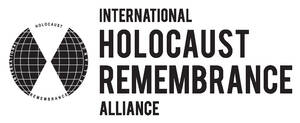
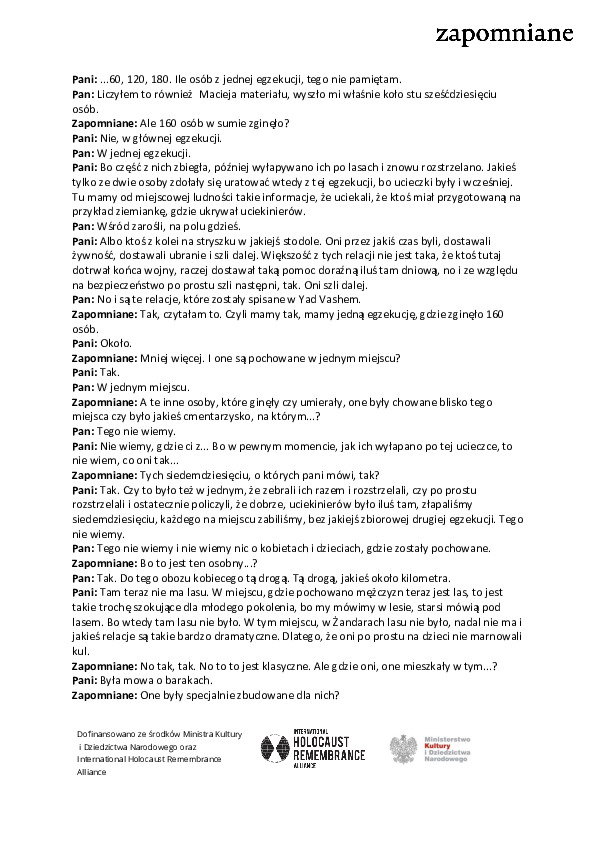 Izabelin - transkrypcja
Izabelin - transkrypcja